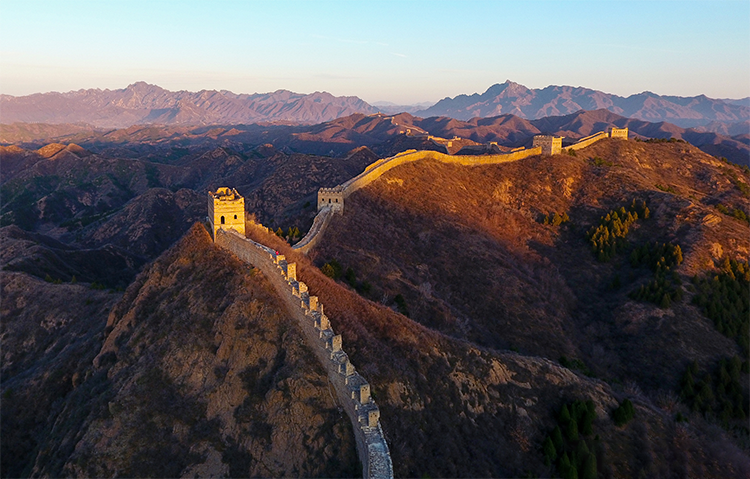Jinshanling Great Wall: Hiking Guide to the Rugged Ming-Era Fortress
When the first golden rays of sunrise spill over the Yanshan Mountains, the Jinshanling Great Wall rouses like a gilded dragon winding across steep ridges. Unlike the crowded sections at Badaling, Jinshanling preserves the raw spirit of the Ming-era frontier: 67 watchtowers set like bronze plates along a 10.5 km spine, each weathered brick bearing military intelligence from centuries past. Listed with the Great Wall as a World Cultural Heritage site in 1987, this “Great Wall museum” speaks in stone — through perilous curtain walls, rare inscribed bricks, and dramatic seasonal landscapes that together tell a three-dimensional military epic.
1. Why Jinshanling is the Great Wall’s “Special Forces”
“Inscribed-brick” codes
Run your fingers over the masonry and you will find many blue bricks engraved with formal inscriptions such as “Wanli 5th Year, Shandong Left Construction,” records unique to the Ming period that identify construction units and dates — like military archives frozen in time. Even rarer is the section’s barrier-wall design: a secondary 2-meter-high interior screen wall built behind the main parapet. If attackers breached the outer wall, defenders could still fire from the elevated interior, creating a layered defense system virtually unique along the Great Wall.
Qi Jiguang’s military genius
In 1567, the famed anti-piracy general Qi Jiguang was assigned to the Jizhen garrison and adapted coastal defensive tactics to the northern frontier. At Jinshanling, some watchtowers are spaced as close as 50 meters, with features such as arrow slits, observation holes, storage rooms, and even primitive “earth-air-conditioning” ventilation. From commanding towers like the General’s Tower you can see 67 towers, square and round, and the three-story black towers with hollow cores still stained by gunpowder — physical traces of Ming firearms and tactical evolution.
2. The Great Wall’s seasonal aesthetics
Autumn (mid-October to early November)
The Yanshan range turns into a giant palette: Chinese sumac, maples and oaks wrap the wall in flame-red robes. Mornings with thin mist reveal the wall weaving through red foliage — a scene listed by China National Geographic among North China’s top autumn views.
Winter (December to February)
The most striking moments follow fresh snowfall. Snow caps the crenellations, icicles drip like crystal curtains, and the crunch of boots on frozen snow alongside silhouetted towers creates the purest Great Wall image. Photographers often trek as early as 4:00 AM to catch the rare “snow-serpent swallowing the sun” spectacle.
Other seasonal tips
Spring is ideal for drone shots when wildflowers carpet the slopes. In summer, sea-of-clouds effects are common (arrive before 6:00 AM for the Five-Eye Tower). Avoid afternoon thunderstorms in July and August.

3. Immersive visitor guide
Hiking routes
– Classic 3-hour route (family friendly): Scenic entrance → Brick Crenel → Shalingkou (cable car descent). This route passes 24 towers and showcases the barrier-wall highlights.
– Intensive 6-hour traverse (for hikers): General’s Tower → Taochun Pass → East Five-Eye Tower. Expect the “Heavenly Ladder” steep section (70-degree steps); trekking poles recommended.
– Sunrise & starry-night option: Book a local guesthouse in advance and ascend from Houchuan Gate at 4:30 AM with headlamps to watch the dawn light flood the cloud sea toward Simatai.
Photography hot spots
– Xiao Jinshan Tower: frame the S-shaped wall for iconic curves.
– Storehouse Tower: the only Ming-era wooden roof structure well preserved.
– Western Platform: best vantage for golden-wall sunsets.
4. Practical information
Getting there
– By car: From Beijing Wangjing West → Jingcheng Expressway → Jinshanling exit (about 1.5 hours). Parking is available at both East and West gates.
– Bus: Take the Jinshanling Great Wall shuttle from outside Beijing Dongzhimen Station (daily departure 07:40, ¥50 including admission).
– Note: Cross-boundary hikes from Simatai require an advance “crossing hiking permit.”

Tickets and facilities
– Admission: Peak season (Apr–Oct) ¥65; off-season ¥55. Entrance includes access to the on-site Great Wall museum.
– Special services: West Gate offers Ming-dynasty armor rentals (¥30/hour) and AR military sandbox displays inside towers (scan QR codes to unlock simulations).
– Accessibility: A cable car runs from Brick Crenel to Shalingkou (one-way ¥40), but roughly 80% of the area requires walking.
When sunset gilds the battlements and you stand atop a ruined beacon tower, you suddenly understand why historian Stein called this place a “living military textbook.” Compared with the polished grandeur of Badaling, Jinshanling feels like a battlefield forgotten by time — its leaning steps test knees, its timeworn inscribed bricks invite interpretation, and its silent towers watch as steadfastly as sentries six centuries ago. This is World Heritage in its most authentic form: unembellished, tactile, and demanding that you walk the wall to touch China’s hard-core historical spine.
Traveler’s note:
Download the “Jinshanling AR Guide” app before your visit; scanning tower numbers animates Qi-family troop tactics. If you meet a goatherd on the slopes, listen to the oral legends of the “Great Wall night-watchers” — here, every brick often tells a richer story than the history books.


